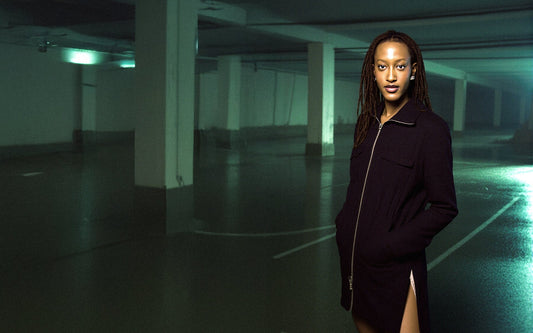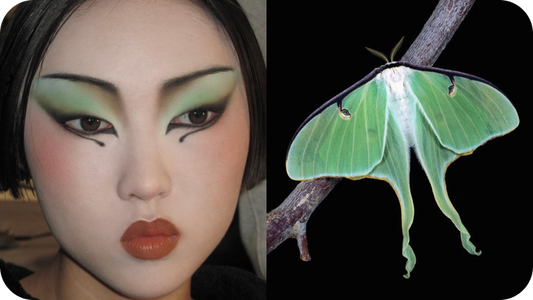Mahoro Seward is a London-based journalist, editor, and the Acting Fashion Features editor at British Vogue. Seward has contributed to publications including Frieze, i-D, AnOther, 1Granary, and SHOW Studio, focusing on fashion, fine art, and pop culture.
Readers of a certain age will recall the 2006 launch of the 2nd generation iPod Nano as a watershed moment in the development of their relationships with technology. To me, its powerful resonance was less due to its restrained formal design, but rather its zingy colorways. Cobalt blue, moon rock silver, scarlet red, Barbie Dreamhouse pink… mine, for the record, was a lurid green – a hue my 11-year-old self felt was a fitting foil for the torrented early Ed Banger releases and J-metal I would later load onto it from the family’s amethyst iMac (my mother’s choice) that evening.

The opposite of an inconsequential decision, that color choice felt like an earnest – vital, even – expression of identity. Today, seeing them pop up on mood boards as emblems of a given phase in portable tech history, I am still moved by a nostalgia for a time when a colored sliver of anodized aluminium – and the 4GB of self-curated sound it held – served as a physical token of one’s sense of self.
Of course, similar can be said of many other devices of the same era: Gameboy Colors, Walkman slide phones, Motorola Razrs… each evoked a human eccentricity in their design – a blend of wide-eyed futurism, fun and personality that invited a strong degree of identification from their users.
Observations of a current nostalgia for the zany tech designs of the early 2000s can easily be pinpointed to familiar trend theoretical frameworks like the '20-year cycle’, but the cultural context it is a product of warrants deeper examination. More than a naïve rehashing of newly vintage aesthetics, it is a response to a widespread flattening of portable – and wearable – tech design between then and now.
This ostensible dulling can in part be attributed to the prosaic intentions that informed the development of early wearable tech pieces, many of which were adapted from medical technology devices that – by their very nature – tended to prioritize function over form. “Wearable tech, in my understanding, started out as a proposition for health and wellness around 15 years ago, with pieces like clunky step-counting devices,” notes Ana Viktoria Dzinic, an artist, researcher and consultant whose work interrogates the aesthetic philosophies of technology and pop culture.

A parallel thread to factor in is the extent to which the portable tech market has been dominated by players that directly cater to a Gen X and millennial-centric appetite for aesthetic minimalism. “The homogenisation of tech aesthetics can be traced to the dominance of monopolistic players like Apple, whose minimalist and functional design philosophy has set a global standard,” argues Amy Francombe, a fashion and culture writer and consultant. For her, the standardized aesthetic of today’s most popular tech devices have developed in tandem with a general homogenisation of culture at large, with “today’s tech designs [becoming] sterile, mass-produced, and relentlessly efficient, mirroring the monotonous and soulless pace of modern life” and “[reflecting] a cultural shift toward functionality at the expense of creativity; a loss of the imaginative diversity that once characterized visions of the future.”
Against this backdrop, a wave of retrofuturistic nostalgia is welling; a collective yearning for a tech aesthetic that germinates from a more optimistic vision of the future is growing at a time when tomorrow’s horizons couldn’t be murkier. “People crave designs that prioritise creativity, individuality, and enrichment over the relentless pursuit of productivity, striving for a future that feels more human and inspired,” Francombe concurs, noting that “as wearable and personal tech becomes ever more advanced, sleek, and multifunctional, retro-inspired designs and objects offer a way to slow down and reconnect with the tactile, symbolic, and experiential qualities of past technologies.”
It is an aesthetic logic that informs the designs of Studio Halia’s recent collaboration with Parisian jewellery brand Hugo Kreit. Taking the cross point of the former’s directional perspective on the fashion-led wearable tech and the latter’s organic-meets-industrial design codes as a point of departure, the capsule’s curvilinear titanium EarCuff and HeadBand, and stainless steel NeckCuff evoke the retro designs of Sony Walkmans, early Bluetooth headsets and, yes, 2nd gen iPod Nanos. Their nostalgic spirit is countered by the advanced technology that each piece houses, with the scanning of the chip unveiling a series of customisable digital extensions, concepted / co-designed by makeup artist Ana Takahashi.
If the pieces invoke the aura of almost naive optimism that emanated from tech designs in the early 2000s – an era when our collective relationship to technology was one conditioned by awe, imaginative expansion, and possibility – that can in part be put down to intentional referencing. “Looking at an increasing number of gadgets today, they seem to rather mimic fashion trends around image consumption,” notes Dzinic, citing the revival of wired headphones – spearheaded by modern-day it-girls like Lily-Rose Depp – as a case in point.
“For one thing, we’re seeing an age where wearable tech is increasingly seen as a purely stylistic proposition. Technology within the 21st century has now fully integrated – and is reproducing – a cycle of vintage aesthetic motifs, spanning the Nokia snake game, Windows’ Clippy mascot, the iPod Nano, and the original, colorful iMacs.”
More than savvily tapping into a nostalgic cycle, however, this burgeoning nostalgia for a time when tech was more ‘fun’, so to speak, chimes with an uncanny resonance between how we currently engage with technology, and how we engaged with it around two decades ago. Indeed, we then stood – and now stand – at the threshold of a new chapter in our collective relationship with technology, peering towards the possibilities it opened with a blend of curiosity and excitement. As technologies including AI, Web 3 and advanced AR – such as that deployed in the STUDIO HALIA x Hugo Kreit collection – percolate further into the fabric of our everyday lives, it makes sense that the devices created to broach these thresholds should embody a degree of speculative optimism in their design.

Such developments could arguably herald a schism with the sober, function-led design aesthetics of much of the wellness-oriented wearable tech that has dominated the space, bringing about a new genre of tech devices that directly cater to a cultural appetite for personal expression, eccentricity and individuality – a fact well proven by the popularity of device customisation. As Dzinic notes, “the health angle which started the wearable tech boom has not yet filled the desire for symbolic value or identity expression. For wearable tech to successfully integrate into fashion culture, it has to comply with and facilitate the creation of lore, identity and cultural signification.”
The territories that technologies like STUDIO HALIA’s open up are worth observing on the grounds of the technology itself. Perhaps more intriguing are the implications that it could have on how we collectively perceive and engage with it. In moving beyond a logic of function-first application, the remit of wearable technology is broadening to both complement and enhance our capacities for self-expression. Granted, the wider resonance of such technologies is somewhat contingent on their ability to challenge – and ultimately disperse – the aesthetic dominance exerted by a handful of players. “While I desperately hope we’ll see more diverse and creative wearable technologies emerge, I can’t say I am optimistic – if Apple’s monopoly on phones is anything to go by I’m not holding my breath,” Francombe demurs. Still, just as this new frontier in wearable tech opens new frontiers of possibility, its collateral effects are impossible to calculate quite yet. “While only a small part of the population is interested in wearable tech, I think that’s about to change…” she adds. All it takes is you being part of it to see what that change could look like.
 Log in
Log in



